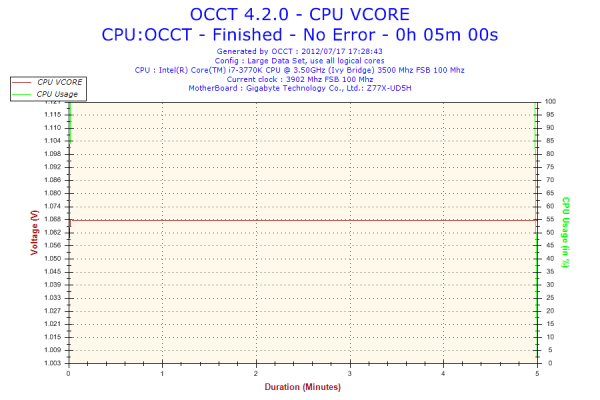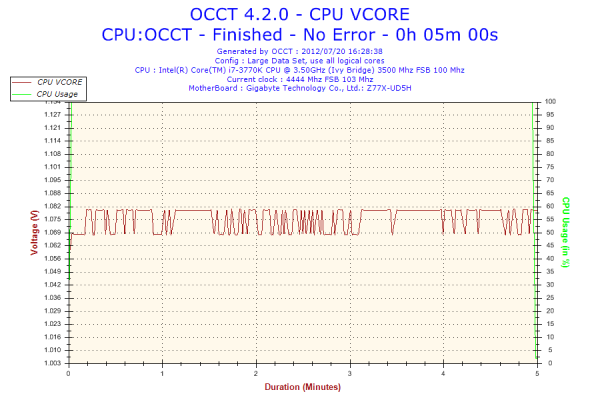Gigabyte GA-Z77X-UD5H Review: Functionality meets Competitive Pricing
by Ian Cutress on July 25, 2012 5:00 AM EST- Posted in
- Motherboards
- Gigabyte
- Z77
Gigabyte GA-Z77X-UD5H In The Box
Gigabyte boxes are typically a bit bare, to cater with Gigabyte's philosophy of trying to reach the price point below the one the board should be placed. Typically, this means not much more than a pair of SATA cables - with the Z77X-UD5H, we get:
IO Shield
Driver CD
Quick Start Guide
Manual
Four SATA cables
Flexi-SLI connector
Front USB 3.0 panel

With a motherboard that has three different USB 3.0 headers on the board, the inclusion of a USB 3.0 panel is a no-brainer. Users of modern cases will also have the opportunity to add two USB 3.0 ports of their own with the case. With the motherboard using an x8/x4/x4 combination of PCIe 3.0 lanes, it is a little surprising we do not see a rigid SLI connector here, if not for three cards then at least for two.
Voltage Readings
After my first publication of OCCT voltage readings, a few readers responded with a more in-depth reasoning behind some of the results we were seeing. With this in mind, I would like to re-describe what we are doing with this test, and how it comes about.
Much of what an enthusiast overclocker does is monitor CPU temperature and voltage. Whatever settings a user places in the BIOS or OS is at the mercy of the motherboard - in terms of actually setting the values and reporting the values back. As an enthusiast, we have to rely on what readings we get back, and hope that motherboard manufacturers are being honest with their readings.
Take CPU voltage. What we as a user see in CPU-Z or OCCT is a time-averaged value that hides voltage ripple (if any) for power delivery. It is very easy for a motherboard manufacturer to hide this value, or to disregard slight deviations and report a constant value to the user. The CPU voltage reading can be taken at a variety of places on the power plane, which can vary between motherboards and manufacturers, meaning that each reading is essentially not comparable with the other. Nevertheless, as an enthusiast, we will constantly compare value A with value B.
Whether or not I can achieve 4.7 GHz with 1.175 volts on a particular board is inconsequential - your motherboard may perhaps produce the same result with a reading at 1.200 volts. The only way to test the actual value is with consistent methodology is via an oscilloscope connected to similar points on each board. This may sound like taking an OCCT reading is therefore redundant.
However, motherboards have settings relating to load line calibration. As load is applied to the CPU, the voltage across the processor decreases (VDroop). Load Line calibration essentially attempts to control this level of droop, by increasing voltage when voltage drops are detected away from a fixed value. Manufacturers have different ideas on how to modify LLC with respect to load, or whether the level of modification should be controlled by the user. Some manufacturers offer the option at a variety of levels, such that overclockers can be sure of the applied setting (even if it increases peak voltage, as explained by AnandTech in 2007).
By doing a full load OCCT test, we are essentially determining both how aggressive the motherboard is reporting the CPU voltage under load and how aggressive load line calibration is performing (from the point of view of the user without an oscilloscope or DVM). If someone has one of the motherboards we have tested and you have a different one, variations in load voltage should describe the offset you may require for overclock comparisons.
As with previous Gigabyte boards, we get a straight line for voltage reading in OCCT. This draws distinct parallels with the previous Gigabyte Z77 boards we have tested - the Z77X-UD3H and the Z77MX-D3H. With the D3H, we found out that Gigabyte was purposely fixing this value, introducing middleware to make sure this value never changed in the OS (as it did not change during overclocking).
Therefore during overclocking on the Z77X-UD5H we also ran the test. We set the VCore in the BIOS to 1.150 volts and got the following result:
Despite the VCore being correctly reported in CPU-Z, in OCCT (in HWMonitor mode), we can see that for some reason it is being fed either the wrong data, or manipulated data. Given our previous experiences with the Gigabyte Z77MX-D3H and the fact that the data fed to OCCT was being manipulated (i.e. overclock voltages were not being fed through to the OS, but were fixed by middleware), it seems rather odd for the motherboard to be performing similarly here.
| Reported Load Voltage / V | |
| ASRock Fatal1ty Z77 Professional | 0.956 |
| ASRock Z77 Extreme4 | 1.050-1.058 |
| ASRock Z77 Extreme6 | 1.040-1.048 |
| ASUS P8Z77-V Deluxe | 1.085 |
| ASUS P8Z77-V Pro | 1.090 |
| Biostar TZ77XE4 | 1.036 |
| Gigabyte Z77X-UD5H | 1.067 |
| Gigabyte Z77X-UD3H | 1.067 |
| MSI Z77A-GD65 | 1.020 |












70 Comments
View All Comments
IanCutress - Tuesday, July 31, 2012 - link
Please note that even if you have purchased a '6Gbit/s' SSD, it will never run at that speed. If you look at our SATA and USB testing, none of the peak speeds we see in our benchmarking ever reach the peak advertised by the port due to the limitations of the hardware. They more often than not do not even reach the peaks of the hardware due to latency or real-world situations. Most rated speeds are for compressible continuous data with a high queue-depth - not ever a realistic scenario.Testing every 3rd party controller adds testing time. Going from 2-3 boards a month do maybe one and a bit. Especially if they're all connected differently on the board (which we don't always know without specific chipset diagrams for the specific product, which are not always available). After all, peak tests are limited in their understanding anyway - take the new USB boost technologies from ASUS and ASRock. ASUS' implementation affects mainly short size block transfers by several order of magnitudes (as found out in our testing), rather than peak by any significant amount.
I am quite astounded by your insistence that if you have many ports that they must all run at their peak speed in conjunction with each other at the same time. It just doesn't work that way. Have a gander at the chipset diagrams in our first Z77 reviews to understand this. Bandwidth is delivered to what needs it at the right time - the usage model for hammering all the ports at once is almost non-existent.
Ideally we'd love to test everything at the peak, but we do not have an unlimited amount of cash to go and buy equipment. We're independent freelance reviewers making do with what kit we can get together or are offered.
iCrunch - Sunday, July 29, 2012 - link
I've become so spoiled by how incredibly seamlessly, fast, and consistent Thunderbolt works. Add to that the fact that I can probably get most of the specs in an external Thunderbolt enclosure/dock solution fairly soon...albeit for a tad more money.Scootiep7 - Sunday, July 29, 2012 - link
Wow, so Gigabyte finally took my complaints to heart and started releasing boards with something other than that ALC887 miserable excuse for an audio codec. Bravo good sirs, better late than never. Now get it done on more of your boards!Questor - Tuesday, July 31, 2012 - link
I have this motherboard with an Ivy Bridge i5 3570K, currently at a stock speed, with a Plextor 128 GB SATA III SSD as the OS drive. Even with the post logo screen enabled, I get to desktop log-in in about 7 seconds. Excluding the "artificially" added time to type my password, full desktop is an average of 2.5 seconds from there. Not bad considering the programs I have that load versus Anantech testing.I have had my board since its early retail release and this has not changed much; even after replacing the original i5 2500K and Samsung SATA II 128 GB SSD for the above mentioned components.
Questor - Tuesday, July 31, 2012 - link
In addition to the boot time being misleading commentary and the response to the USB vs PS/2 keyboard, my present computer build with this Gigabyte board is one of the best/favorite rigs in my 14 years of building and tweaking computers.The other few are ASUS P8P67-PRO, Gigabyte MA790GP-UD4H (X2 with two cores unlocked to quad and STILL running stable), EPoX EP-9NPA+ Ultra, ASUS P5A with AMD K6-350 (severe electrical spike took it out after years of OCing - jumped the surge protector)!
Questor - Tuesday, July 31, 2012 - link
In addition to the boot time being misleading commentary and the response to the USB vs PS/2 keyboard, my present computer build with this Gigabyte board is one of the best/favorite rigs in my 14 years of building and tweaking computers. The other few are ASUS P8P67-PRO, Gigabyte MA790GP-UD4H (X2 with two cores unlocked to quad and STILL running stable), EPoX EP-9NPA+ Ultra, ASUS P5A with AMD K6-350 (severe electrical spike took it out after years of OCing - jumped the surge protector)!minlian - Sunday, August 12, 2012 - link
Is the reaction time DPC Latency error fixed on the Gigabyte Z77X-UD5H-WB-WiFi version or are they just the same motherboard with just a wifi difference?Triniman - Sunday, August 12, 2012 - link
Ian Cutress wrote, "...a total of 10 USB 3.0 ports available (if you have enough USB 3.0 panels)."Does anyone know of any cases that will would allow you to use the 3 onboard USB 3.0 headers?
Also, is it correct that the Gigabyte doesn't include drivers for these VIA controllers?
ETruett - Tuesday, September 11, 2012 - link
Hay. I am wondering if the Gigabyte GA-Z77X-UD5H Motherboard will fit in the Dell E510 Case? Or which Case can i get? I would like to build a nice gaming pc that whill not break me. I dont have much money. My eMail is: etruett9@gmail.com..... :-))gkatsanos - Monday, November 26, 2012 - link
Hi, It's weird how in any of the reviews there was a word for the problems (bugs) this M/B has. I ordered it a week ago and even if I upgraded my BIOS to the latest version, it still suffers from problems.. I had for example to disable the Marvell sata controller and connect my drive to the intel chipset one for the system to shutdown properly... Other folks have had freezes etc. Google the model + problems and you'll see. I am thinking of changing it with an Intel m/b or something more stable..